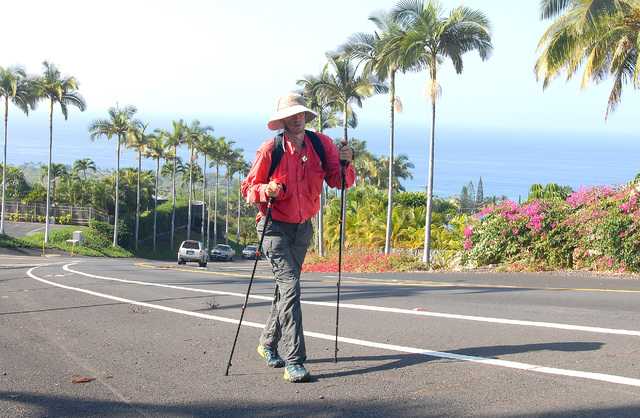At the end, Dr. Cliff Kopp, having thinned down from the grueling trek, collapsed at the finish line where he was cheered by loved ones and well-wishers. ADVERTISING At the end, Dr. Cliff Kopp, having thinned down from the grueling
At the end, Dr. Cliff Kopp, having thinned down from the grueling trek, collapsed at the finish line where he was cheered by loved ones and well-wishers.
Despite the turnout to mark his momentous occasion, Kopp insisted the moment wasn’t meant for personal recognition.
“It was never about me,” said Kopp after he finished his walk around the entire Big Island on Friday, New Year’s Day, on which he embarked on Christmas Eve to draw attention to the lack of support for homeless people.
“The government wasn’t doing anything,” he said, “so I walked.”
Kopp is pushing for more long-term beds on the island so homeless people can get a “hand up, not a hand out.” His trek, he said, gave him a bit of an insight into the suffering contingent of being homeless. Most of the time, he didn’t feel suffering, just pain. He tore a muscle in his leg early on, but that was nothing compared to the issues he was trying to present.
It’s an hour-to-hour, almost feral life, he said. More people need a place to stay, and a place that’s more than a temporary shelter. He pointed to the fact that in the past four years the number of homeless people has grown, while the county has not added a single homeless bed.
They need the support, he said, as many homeless people have been mugged or otherwise lost their identification. Without that identification getting a job is nearly impossible and they can’t get access to social services they are entitled to, he said.
“The only thing reducing unsheltered homelessness is, well, suicide,” he said.
It’s a sobering realization that he came to really understand while walking in Hamakua. A big part of the journey was to put himself in the homeless’ shoes, so to speak.
And he felt exactly that.
“It would be so easy to go over this bridge,” he remembered thinking.
And that’s for the adults. About 30 percent of all homeless people on the island are children. Half of the children in school qualify for free or reduced lunches due to low income, said Kristin Frost Albrecht of the Hawaii Food Basket, who visited with Kopp on one of his stops during his walk.
In all, the trip was about 240 miles, began in the early morning hours on Dec. 24, and ended about 10:30 a.m. Friday.
“About the only friends I had along the way was the mile markers,” Kopp said.
He did have periodic visitors who would bring him companionship and meals, including stew and turkey sandwiches. Originally he’d planned to camp out every night on his way around the island. But he soon realized that was unsustainable, he said. He did four days on about five hours sleep, he said, before deciding to stay indoors.
One of the worst nights was camping in a gulch in Waimea with high winds tearing at him.
It was worsened by the fact he was about 20 feet from the emergency room parking lot.
It took every ounce of will to not go into the ER, he said, but he knew if he did the trip was over.
His trek was chronicled on Facebook, with people reporting sightings and interactions with Kopp. Kopp was also walking in support of the Hawaii Food Basket, a local food pantry. Albrecht said they saw a significant amount of money come in during the walk.
After the end, where Kopp spread out on the ground and was greeted by his loving dogs, among others, the moment sunk in a bit more. After seeing some of the pictures people took of him, he sent out a message of thanks.
“All things taken into consideration, I look mighty awful,” he wrote to the group.



